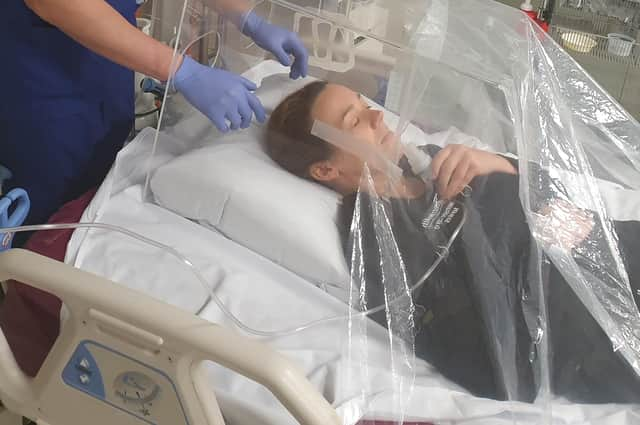Aerosol boxes increase exposure to airborne particles


The authors of the Australian research say the danger posed to frontline health workers exposed to infectious coronavirus is significant.
The sickest Covid-19 patients often need to be placed onto a ventilator, which is also when the risk to the health worker of exposure is potentially at its greatest.
Advertisement
Hide AdAdvertisement
Hide AdThis has created a race to manufacture aerosol containment devices including improvised protection strategies and devices for use during tracheal intubation.
It has taken on even greater urgency in the last week, with a global “second wave” becoming more likely, and a recent open letter to the World Health Organisation (WHO) from 239 global scientists in 32 countries warning we have been severely underestimating the amount of Covid-19 spread through fine aerosol droplets over large distances.
On Wednesday, WHO formally acknowledged this emerging evidence regarding potential spread of Covid-19 through these tiny droplets.
Aerosol boxes have been promoted by worldwide news organisations and across social media as not only a quick and simple solution to protecting frontline workers but also an example of private industries stepping up production to support frontline healthcare workers.
However, these devices were produced outside the normal regulatory framework, and thus were never clinically tested or validated for effectiveness and safety.
Yet despite this heavy media promotion, no international guideline on personal protective equipment (PPE) has ever endorsed their use.
The authors say: “We were surprised to find airborne particle contamination of the doctor increased substantially using the aerosol box compared with all other devices and with no device use.
Spikes of airborne particles were clearly seen, coinciding with patient coughing. We believe that these represent particles escaping from the arm access holes in the aerosol box.”
Advertisement
Hide AdAdvertisement
Hide AdThe authors who include Drs Peter Chan, Joanna Simpson and colleagues, Intensive Care and Anaesthesia Specialists at Eastern Health in Melbourne, say: “The race to generate sustainable equipment to protect healthcare workers during intubation procedures in patients with suspected or proven Covid-19, particularly in settings where PPE supply is limited, has flooded the scientific community and social media with a variety of novel devices meant to contain potentially infectious aerosols produced by patients. Evidence for the safety and efficacy of these devices is lacking.”
They conclude: “This study demonstrates devices such as the aerosol box we tested - confer minimal to no benefit in containing aerosols during an aerosol-generating procedure and may increase rather than decrease airborne particle exposure.”
A message from the Editor:
Thank you for reading this story on our website. While I have your attention, I also have an important request to make of you.
The dramatic events of 2020 are having a major impact on many of our advertisers - and consequently the revenue we receive. We are now more reliant than ever on you taking out a digital subscription to support our journalism.
Subscribe to scotsman.com and enjoy unlimited access to Scottish news and information online and on our app. Visit https://www.scotsman.com/subscriptions to sign up.
By supporting us, we are able to support you in providing trusted, fact-checked content for this website.
Joy Yates
Editorial Director
Comments
Want to join the conversation? Please or to comment on this article.